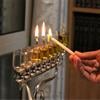Against the backdrop of the glittering Manhattan skyline, the world’s largest menorah stood ablaze at the corner of Fifth Avenue and 58th Street in Manhattan, a beacon of hope amid a year marked by the war in Israel and rising antisemitism across the United States.
As Rabbi Shmuel Butman, director of the Lubavitch Youth Organization and organizer of the event, prepared to light the first light of the menorah, he was joined on stage by New York Gov. Kathy Hochul, who addressed the crowd.
“Chanukah is a reminder of the strength, the resiliency and the ability to find light through darkness,” she remarked on the crisp December evening. “And if ever in our history in New York we have needed to find light after darkness, it is right now.”
“I want to make sure everyone knows that I’m working hard to keep you all safe,” she continued. “We are making sure that everywhere you go to worship and celebrate this great holiday, that you will be safe because there is no room for hate in the great state of New York. Happy Chanukah everybody!”
The gleaming two-ton menorah, which was designed by Israeli artist Yaacov Agam and inspired by a Maimonides drawing, stands as one of the most photogenic examples of the Chanukah awareness campaign that was launched 50 years ago by the Rebbe—Rabbi Menachem M. Schneerson, of righteous memory—in 1973. In the half-century since the campaign’s inception, it has transformed the holiday, bringing it to the American mainstream and making it an integral part of not only Jewish life but also American culture.

As Butman ascended the cherry-picker to light the inaugural light, he mentioned the unique place the Fifth Avenue Menorah has in the context of the Rebbe’s campaign. “The menorah was personally approved of by the Rebbe and a small scale replica even sat on the Rebbe’s desk for a little while before it was built,” he shared with the crowd.
“This year’s celebration is even bigger and more comprehensive than we’ve ever done before,” added Butman. “Just like Judah the Macabee did not negotiate with the enemy, neither should we.”
After the crowd watched the lighting and joined Butman in a stirring rendition of “Maoz Tzur,” which was especially resonant against the backdrop of antisemtism facing Jews worldwide, Hochul spoke again, sharing a surprising personal anecdote: The governor had received the news of her father’s passing while she was preparing to leave for a trip to Israel soon after the Oct. 7 terror attacks in Israel. She shared with the crowd her resolve to visit Israel in solidarity with the Jewish people despite her personal loss.
“I went to the Wailing Wall [the Western Wall or Kotel] the next morning [after my father’s passing], I put two messages in. One for the people of Israel, because they were dealing with such pain and suffering, and I wanted to comfort them. And also one for my father,” she shared as the flames of the menorah danced behind her. “All he wanted to do was go to Israel. He had been there just a few years earlier. He had gone to the Wailing Wall as well. So it was important for me to go.”
“The menorah will increase in light, growing brighter night after night, and serve as a powerful symbol of the Jewish people’s unwavering spirit,” said Butman. “It stands as a reminder that even a little light can overcome a great deal of darkness, and may the lights of Chanukah usher in the eternal lights of the great redemption.”









Start a Discussion